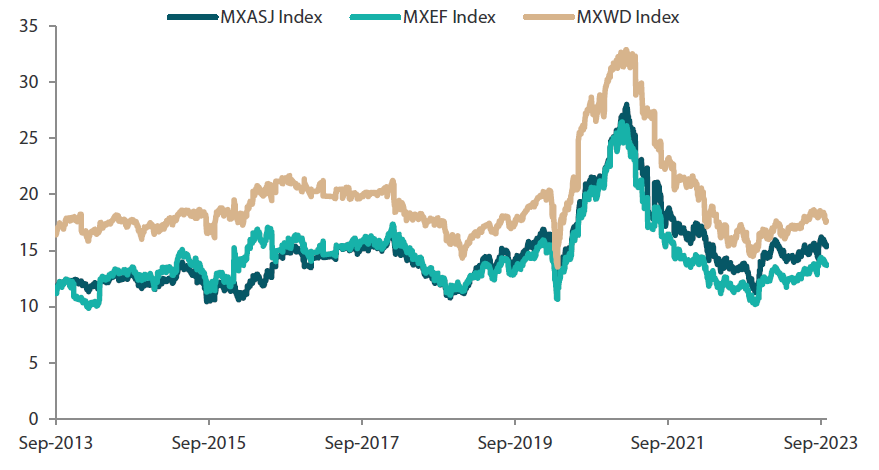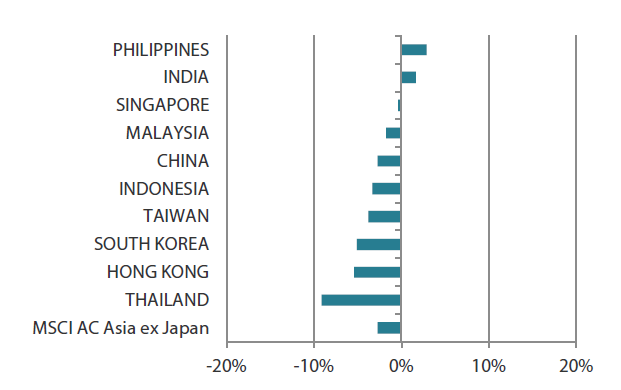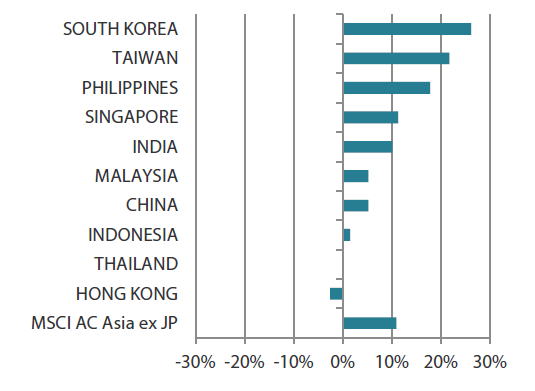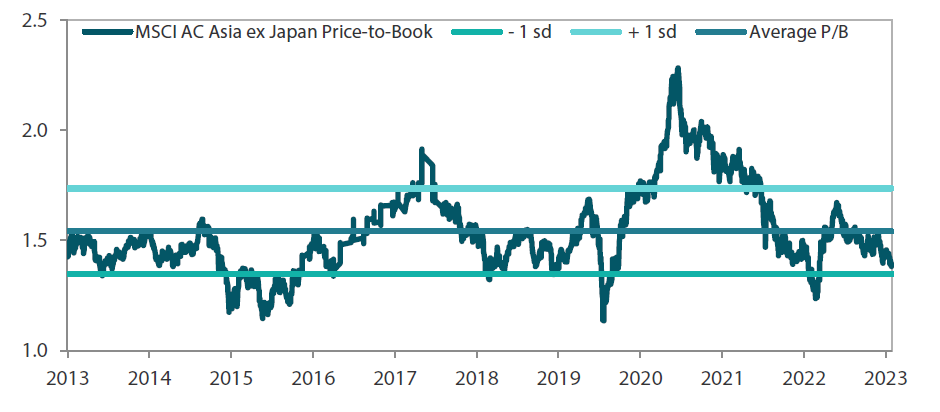Summary
- With oil markets closing in on US dollar (USD) 100 per barrel and US bond yields reaching 16-year highs, one could be excused for being struck by a bout of conservatism. With valuation dispersions again back to all-time highs, we contend that the risk-reward looks more favourable when taking a long-term view of Asia.
- For the month, the MSCI AC Asia ex Japan Index declined 2.7% in USD terms as investors globally reacted to a surge in longer-term government bond yields and higher oil prices.
- Thailand (-9.1%), Hong Kong (-5.4%) and South Korea (-5.1%) led the losses, whereas the Philippines (+2.9%) and India (+1.7%) bucked the regional downtrend.
- In China, our focus is on companies that are more geared towards domestic demand. India and Indonesia offer some of the brighter opportunities within Asia, whilst South Korea and Taiwan should continue to ride the global artificial intelligence (AI)-driven hardware buildout trend.
Market review
Asian markets slump on a surge in bond yields and higher oil prices
Regional equities, as measured by the MSCI AC Asia ex Japan Index, declined 2.7% in USD terms in September as investors globally reacted to a surge in longer-term government bond yields. While the US Federal Reserve held interest rates steady, the central bank’s officials signalled that they expect to keep rates higher further into 2024. Meanwhile, higher oil prices contributed to concerns that inflation could prove more difficult for central banks to tame.
Chart 1: 1-yr market performance of MSCI AC Asia ex Japan vs. Emerging Markets vs. All Country World Index

Source: Bloomberg, 30 September 2023. Returns are in USD. Past performance is not necessarily indicative of future performance.
Chart 2: MSCI AC Asia ex Japan versus Emerging Markets versus All Country World Index price-to-earnings

Source: Bloomberg, 30 September 2023. Returns are in USD. Past performance is not necessarily indicative of future performance.
Hong Kong and South Korea lead the losses in North Asia
Deepening worries over China’s ailing property sector continued to weigh down China stocks, which fell 2.8% in September. Improving economic data and promises of more monetary stimulus from the People’s Bank of China (PBOC), however, helped to mitigate losses for Chinese equities near the month-end. China's industrial production, retail sales and manufacturing activity improved in August from the prior month, while consumer prices rose by 0.1% year-on-year (YoY), allaying fears that the country is facing a deflationary spiral. During the month, the PBOC announced a 25-basis-point reduction in the reserve requirement ratio for all banks, adding that it would use step-up measures to increase private investment in the country.
In Hong Kong, stocks sank 5.4%, pressured by China’s deepening property woes and a surge in oil prices, which stoked fresh worries over the impact on inflation and consumer spending for the financial hub. Elsewhere, a downturn in global technology stocks dampened investment sentiment in the technology-centric markets of South Korea (-5.1%) and Taiwan (-3.8%) in September. A slump in the share price of index heavyweight Taiwan Semiconductor Manufacturing Company, plus concerns that major central banks would keep interest rates higher for longer, also weighed down these tech-centric markets for the month.
Thailand nosedives over 9%, while the Philippines bucks the regional downtrend
Most equity markets in the ASEAN region fell in September. Thailand (-9.1%), Indonesia (-3.3%), Malaysia (-1.7%) and Singapore (-0.4%) turned in losses, whereas the Philippines (+2.9%) bucked the regional downtrend. The central bank of the Philippines extended its rate pause for a fourth consecutive meeting, although officials said a resumption of tightening is possible at the next meeting if inflation continues to tick up. Central banks in Indonesia and Malaysia also adopted the same no-change stance, keeping their benchmark rates steady at 5.75% and 3.00%, respectively. Thailand—the worst performing regional market in September—cut energy prices and froze farmer debt as the new government rolled out measures to ease the cost of living and spur economic growth. The Bank of Thailand unexpectedly raised its key interest rate by another quarter-point. Singapore's industrial output in August fell 12.1% YoY, contracting for the eleventh consecutive month and more steeply than expected, mainly due to a slump in electronics.
Indian equities fare relatively better
For the month, Indian stocks rose 1.7% as the country’s annual retail inflation eased to 6.83% in August from a 15-month high of 7.44% in July as food prices moderated. Furthermore, JPMorgan’s announcement that it will include India in its widely-tracked benchmark emerging market debt index lifting investor sentiment.
Chart 3: MSCI AC Asia ex Japan Index1
| For the month ending 30 September 2023 | For the year ending 30 September 2023 | |

|

|
Source: Bloomberg, 30 September 2023.
1Note: Equity returns refer to MSCI indices quoted in USD. Returns are based on historical prices. Past performance is not necessarily indicative of future performance.
Market outlook
Focusing on companies in China that are more geared towards domestic demand
With oil markets closing in on USD 100 per barrel and US bond yields reaching 16-year highs, one could be excused for being struck by a bout of conservatism. A staggering amount of fiscal impulse in the US and the continued focus on generative AI’s development have led global markets higher of late, seemingly in disconnect to the weakening position of most companies outside of the “Magnificent Seven”, namely Apple, Alphabet, Meta, Amazon, Microsoft, Nvidia and Tesla. Asia, on the other hand, has seen an easing of inflationary pressures, while interest rates remain on hold for most countries; easing measures have even been stepped up in its largest economy—China. With valuation dispersions again back to all-time highs, we contend that the risk-reward looks more favourable when taking a long-term view of Asia and the emerging markets.
In China, the authorities are addressing the continuing lack of domestic confidence and deteriorating economic conditions. While in the long term, China’s move to curtail excesses in the property market could result in better quality growth, the transition has been anything but orderly. The authorities have stepped up support measures, implementing nationwide property policy easing together with multiple actions to restructure local government debt. These measures have been enough to cause some steepening in local bond curves, but equity markets remain unconvinced. With valuations and positioning at their cheapest and lowest, respectively, risk-reward would seemingly be on the upside from here but contingent on stronger policy support. In our view, stock selection has never been more important in regard to China. Our focus is on companies that are more geared towards domestic demand, especially those helping to secure self-sufficiency and in areas where the supply-demand dynamic is favourable.
India and Indonesia benefiting from global supply chain shifts
The focus on China, however, overlooks some of the brighter opportunities within Asia. Several countries are reforming and positioning themselves for greater supply chain relocation investments. India has justifiably received a lot of the attention. A combination of positive structure reforms and several manufacturing and production-linked incentive programmes are encouraging investment, not just from overseas multinationals but mainly from domestic corporates. This is broad-based and has kept economic activity levels high. The inclusion of Indian government bonds in global bond indices has long been touted and adds further foreign capital inflows, aiding the overall cost of debt. We are mindful of pockets of overexuberance in the Indian local markets, and we remain focused on areas with the most attractively priced sustainable returns and positive fundamental change—namely financials, property and consumption.
We believe that Indonesia remains one of the best-placed within ASEAN as it looks to foster more downstream production of the electric vehicle supply chain. Several reforms are also aimed at improving the ease of doing business and fostering more onshore services including in areas of healthcare and finance. Indonesia remains our most preferred market within the sub-region.
South Korea and Taiwan riding the AI-driven growth trend
Technology heavyweights like South Korea and Taiwan should also continue to ride on the coattails of the global AI-driven hardware buildout trend, albeit against a weak backdrop for most other parts of the overall value chain. We are also increasingly finding more opportunities in energy transition and energy efficiency solutions emanating from the technology sector. Both remain, however, much more geared to global exports, and as the strength in developed markets starts to fade, we believe more caution is warranted overall.
Chart 4: MSCI AC Asia ex Japan price-to-earnings

Source: Bloomberg, 30 September 2023. Ratios are computed in USD. The horizontal lines represent the average (the middle line) and one standard deviation on either side of this average for the period shown. Past performance is not necessarily indicative of future performance.
Chart 5: MSCI AC Asia ex Japan price-to-book

Source: Bloomberg, 30 September 2023. Ratios are computed in USD. The horizontal lines represent the average (the middle line) and one standard deviation on either side of this average for the period shown. Past performance is not necessarily indicative of future performance.
Reference to individual stocks is for illustration purpose only and does not guarantee their continued inclusion in the strategy’s portfolio, nor constitute a recommendation to buy or sell.



